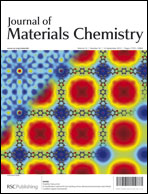A series of planar Ni(II), Cu(II) and Co(II) tetraaza[14]annulenes has been prepared and studied optically, electrochemically and magnetically. Thin films of each of these complexes have been prepared by vacuum deposition to evaluate the field-effect transistor (FET) performance as well as the morphology and crystallinity of the film formed. The electrochemistry and UV/Vis absorption studies indicate the materials are redox active and highly coloured, with molar extinction coefficients as large as 80 000 M−1 cm−1 in the visible region. The paramagnetic complexes display weak antiferromagnetic interactions, fit to the Bonner–Fisher chain model. Each of the materials formed polycrystalline films when vacuum deposited and showed field-effect transistor behaviour, with charge carrier mobilities in the range of 10−5 to 10−9 cm2 V−1 s−1. SEM imaging of the substrates indicates that the central metal ion, and its sublimation temperature, has a crucial role in defining the morphology of the resulting film.
![Graphical abstract: Planar Ni(ii), Cu(ii) and Co(ii) tetraaza[14]annulenes: structural, electronic and magnetic properties and application to field effect transistors](/en/Image/Get?imageInfo.ImageType=GA&imageInfo.ImageIdentifier.ManuscriptID=C2JM33079B&imageInfo.ImageIdentifier.Year=2012)
You have access to this article
 Please wait while we load your content...
Something went wrong. Try again?
Please wait while we load your content...
Something went wrong. Try again?
![Graphical abstract: Planar Ni(ii), Cu(ii) and Co(ii) tetraaza[14]annulenes: structural, electronic and magnetic properties and application to field effect transistors](/en/Image/Get?imageInfo.ImageType=GA&imageInfo.ImageIdentifier.ManuscriptID=C2JM33079B&imageInfo.ImageIdentifier.Year=2012)

 Please wait while we load your content...
Please wait while we load your content...